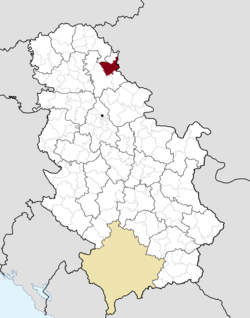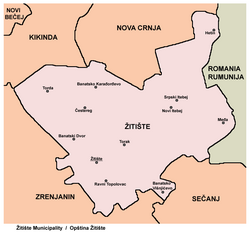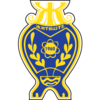Žitište
This articleneeds additional citations forverification.(March 2013) |
Žitište
| |
|---|---|
 Town center. | |
 Location of Žitište within Serbia | |
| Coordinates:45°29′N20°33′E/ 45.483°N 20.550°E | |
| Country | |
| Province | |
| District | Central Banat |
| Government | |
| • Mayor | Mitar Vučurević (SNS) |
| Area | |
| • Total | 525 km2(202.7 sq mi) |
| Elevation | 78 m (256 ft) |
| Population (2022)[1] | |
| • Total | 13,412 |
| • Administrative | 2,550 |
| Time zone | UTC+1(CET) |
| • Summer (DST) | UTC+2(CEST) |
| Postal code | 23210 |
| Area code | +381(0)23 |
| Car plates | ZR |
| Website | zitiste.org |
Žitište(Serbian Cyrillic:Житиште,pronounced[ʒîtiːʃte];Hungarian:Begaszentgyörgy;Romanian:Jitiște) is a town and municipality located in theCentral Banat Districtof the autonomous province ofVojvodina,Serbia.As of 2022 census, the town itself has a population of 2,550, while Žitište municipality has 13,412 inhabitants.[2]
Name
[edit]InSerbian,the town is known asŽitište(Cyrillic:Житиште), inRomanianasJitișteorZitiște,inGermanasSankt Georgen an der Bega,and inHungarianasBégaszentgyörgyorBegaszentgyörgy.
The Serbian name of the town derived from the Serbian word "žito" ( "wheat" in English). Its old names used in Serbian wereBegej Sveti ĐurađandSenđurađ.
The Hungarian name of the town derived from the Hungarian family name Szentgyörgyi.
History
[edit]Žitište was founded in the 14th century during the administration of the medievalKingdom of Hungary,under the name of Zenthgyurgh (Szentgyörgyi). In 1660/1666, it was called Senđurađ, which was recorded as a settlement repopulated by ethnicSerbsduringOttomanrule. In the beginning of the 18th century, the settlement was completely abandoned and in 1723 it was recorded as an uninhabitedheath.
It was settled again in 1724 bySerbandRomaniansettlers. In 1736/37, the settlement had 27 houses. Because of theAustro-Turkishwar (1736–1739) and pestilence, the number of inhabitants decreased and in 1740 the population of the settlement numbered 18 houses. In 1753, Begej Sveti Đurađ was settled by 1,000 Serb frontiersmen fromPomorišje,PotisjeandVeliki Bečkerek,and in the same year it was recorded on map as a "Serb-inhabited settlement"[citation needed].In 1758, Begej Sveti Đurađ had 45 houses, and in 1773 it had 182 houses. Its church was built in 1758, and it was also used as a school. In 1781, Begej Sveti Đurađ became a property ofIsak Kiš(Kis Izsák), who was a trader ofArmenianorigin.
From 1800 to 1805, the settlement was moved to another location closer to theBegejriver. Part of the Serb population moved from the settlement and settled in theMilitary Frontier,whileGermancolonists settled in Begej Sveti Đurađ instead of them. Begej Sveti Đurađ was a municipality until 1877, when it was joined to the municipality ofVeliki Bečkerek.In 1880, the population of the settlement numbered 3,041 people, of whom 1,983 wereCatholics,1,033 wereEastern Orthodox,19 wereJews,and 6 were others. In accordance with the census made in 1910, the linguistic distribution of the 2,814 inhabitants included 1,454 who spokeGerman,1,034 who spokeSerbianand 214 who spokeHungarian.
In 1931, the population of Begej Sveti Đurađ included 1,318 inhabitants who spoke theGerman language,1,055 who spoke theSerbian language,188 who spoke theHungarian language,34 who spoke otherSlavic languages,and 94 who spoke other languages. In 1940, population of Begej Sveti Đurađ numbered 3,055 people, of whom 1,642 wereEastern Orthodox,1,387 wereCatholics,16 wereJews,and 10 were others.
As a consequence ofWorld War IIandAxisoccupation, the German population left or was evicted from Begej Sveti Đurađ after the war, while 270 Serb families fromBosanska Krajinacame to the settlement. In 1947, the name of the settlement was officially changed to Žitište. In 1960, Žitište became a seat of itsmunicipality.
On 2 July 2016, a mankilled his wife in a mass shootingthat occurred at a local cafe. Four others were also killed and an additional 22 were injured. The shooter was arrested by police after the attack.[3][4]
Inhabited places
[edit]
Žitište municipality includes the town of Žitište and the following villages:
- Banatski Dvor
- Banatsko Višnjićevo
- Banatsko Karađorđevo
- Međa
- Novi Itebej(Hungarian:Magyarittabé)
- Ravni Topolovac
- Srpski Itebej
- Torak(Romanian:Torac)
- Torda(Hungarian:Torontáltorda)
- Hetin(Hungarian:Tamásfalva or Hetény)
- Čestereg
Demographics
[edit]| Year | Pop. | ±% p.a. |
|---|---|---|
| 1948 | 36,375 | — |
| 1953 | 35,649 | −0.40% |
| 1961 | 33,514 | −0.77% |
| 1971 | 29,684 | −1.21% |
| 1981 | 25,579 | −1.48% |
| 1991 | 22,811 | −1.14% |
| 2002 | 20,399 | −1.01% |
| 2011 | 16,841 | −2.11% |
| 2022 | 13,412 | −2.05% |
| Source:[5] | ||
According to the 2011 census, the population of the municipality of Žitište was 16,841 inhabitants.[6]
Ethnic groups
[edit]- Municipality
- Serbs= 10,436 (61.97%)
- Hungarians= 3,371 (20.02%)
- Romanians= 1,412 (8.38%)
- Romani= 832 (4.94%)
- Others and undeclared = 790 (4.69%)
Settlements with Serb ethnic majority are: Žitište,Banatsko Višnjićevo,Banatsko Karađorđevo,Međa,Ravni Topolovac,Srpski Itebej,andČestereg.Settlements with Hungarian ethnic majority are:Novi Itebej(Magyarittabé in Hungarian),Torda,andHetin(Tamásfalva in Hungarian). The settlement with Romanian ethnic majority isTorak(Begejci). Ethnically mixed settlement with relative Serb majority isBanatski Dvor(Szőllősudvarnok in Hungarian).
- Town
According to the 2011 census the town of Žitište had 2,903 inhabitants, including:[6]
- Serbs= 2,511 (86.50%)
- Romani= 175 (6.03%)
- Hungarians= 58 (2.00%)
- Others and undeclared = 159 (5.48%)
Language
[edit]Serbian, Hungarian, and Romanian language are officially used by municipal authorities.
Sports
[edit]Gallery
[edit]-
The Eastern Orthodox church of Saint George, built in 1810.
-
The Eastern Orthodox church of Saint George under re-construction
-
Relief depicting Saint George, above the entrance of the Eastern Orthodox church
-
Monument of Rocky Balboa, built in 2007 in Žitište
Notable inhabitants
[edit]Trivia
[edit]In 2007, local authorities unveileda monument in the centre of the town,dedicated to famous, fictional boxerRocky Balboa.[1].In 2009, filmmaker Barry Avrich produced and directed the documentary, "Amerika Idol" about the making and dedication of the Rocky statue.
See also
[edit]- List of places in Serbia
- List of cities, towns and villages in Vojvodina
- Municipalities of Serbia
- Central Banat District
References
[edit]- ^"Census 2022: Total population, by municipalities and cities".popis2022.stat.gov.rs.
- ^"Census 2022 - excel table | ABOUT CENSUS".popis2022.stat.gov.rs.Retrieved2024-09-01.
- ^"Serbian man kills 5, injures 22, in cafe shooting".Reuters.2 July 2016.Retrieved3 July2016.
- ^"Serbia Gunman Kills 5, Including Wife, in Zitiste Cafe Attack".NBC News.2 July 2016.Retrieved3 July2016.
- ^"2011 Census of Population, Households and Dwellings in the Republic of Serbia"(PDF).stat.gov.rs.Statistical Office of the Republic of Serbia.Retrieved19 March2017.
- ^ab"Population by ethnicity – Žitište".Statistical Office of the Republic of Serbia (SORS).Retrieved11 March2013.
Further reading
[edit]- Ljubica Budać, Begej Sveti Đurađ - Žitište, Žitište, 2000.
- Slobodan Ćurčić, Broj stanovnika Vojvodine, Novi Sad, 1996.








